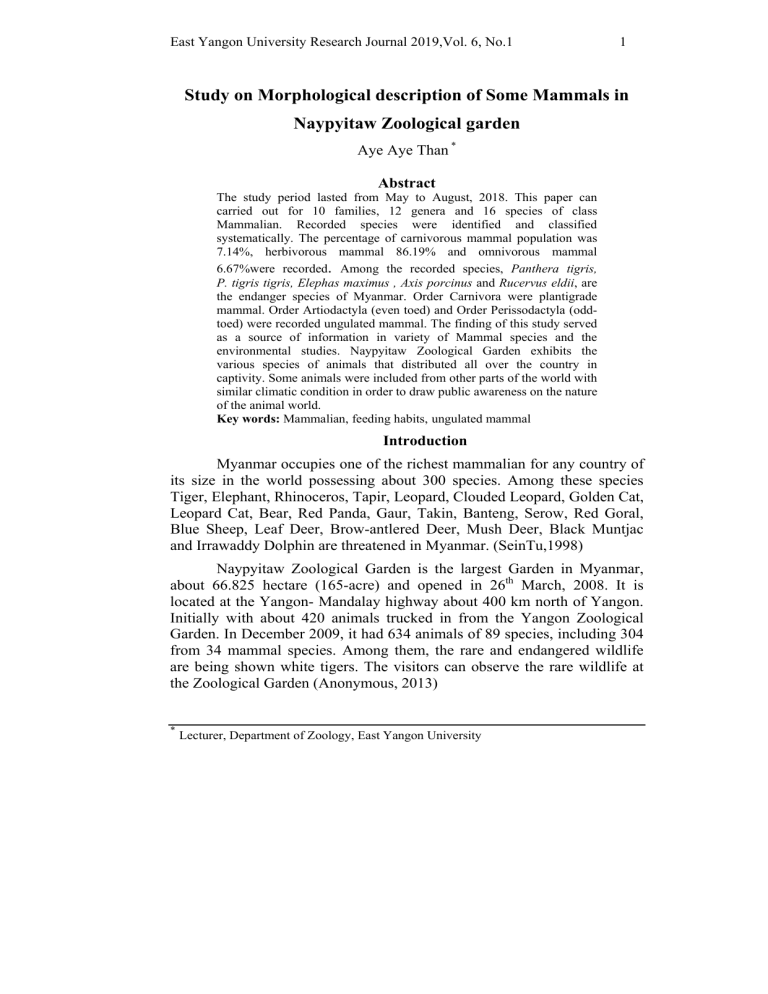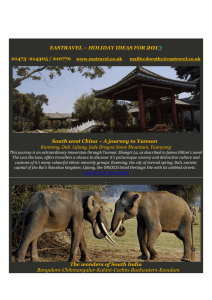
East Yangon University Research Journal 2019,Vol. 6, No.1 1 Study on Morphological description of Some Mammals in Naypyitaw Zoological garden Aye Aye Than * Abstract The study period lasted from May to August, 2018. This paper can carried out for 10 families, 12 genera and 16 species of class Mammalian. Recorded species were identified and classified systematically. The percentage of carnivorous mammal population was 7.14%, herbivorous mammal 86.19% and omnivorous mammal 6.67%were recorded. Among the recorded species, Panthera tigris, P. tigris tigris, Elephas maximus , Axis porcinus and Rucervus eldii, are the endanger species of Myanmar. Order Carnivora were plantigrade mammal. Order Artiodactyla (even toed) and Order Perissodactyla (oddtoed) were recorded ungulated mammal. The finding of this study served as a source of information in variety of Mammal species and the environmental studies. Naypyitaw Zoological Garden exhibits the various species of animals that distributed all over the country in captivity. Some animals were included from other parts of the world with similar climatic condition in order to draw public awareness on the nature of the animal world. Key words: Mammalian, feeding habits, ungulated mammal Introduction Myanmar occupies one of the richest mammalian for any country of its size in the world possessing about 300 species. Among these species Tiger, Elephant, Rhinoceros, Tapir, Leopard, Clouded Leopard, Golden Cat, Leopard Cat, Bear, Red Panda, Gaur, Takin, Banteng, Serow, Red Goral, Blue Sheep, Leaf Deer, Brow-antlered Deer, Mush Deer, Black Muntjac and Irrawaddy Dolphin are threatened in Myanmar. (SeinTu,1998) Naypyitaw Zoological Garden is the largest Garden in Myanmar, about 66.825 hectare (165-acre) and opened in 26th March, 2008. It is located at the Yangon- Mandalay highway about 400 km north of Yangon. Initially with about 420 animals trucked in from the Yangon Zoological Garden. In December 2009, it had 634 animals of 89 species, including 304 from 34 mammal species. Among them, the rare and endangered wildlife are being shown white tigers. The visitors can observe the rare wildlife at the Zoological Garden (Anonymous, 2013) * Lecturer, Department of Zoology, East Yangon University East Yangon University Research Journal 2019,Vol. 6, No.1 Carnivorous animals are distinguished from pawed mammals by their large canine teeth and small incisors. The grinding teeth in the carnivore are generally sharp edged but in those species which adopt a more omnivorous diet, such as the civets, they are broader and more rounded (Tun Yin, 1966). Herbivores are animal anatomically and physiologically adapted to eating plant materials. Herbivores form an important link in the food chain. Herbivores that eat leaves, shoots, and twigs are called browsers. Very large animals like elephants, rhinos, and moose are grazers and browsers. Some herbivores eat all of a plant but others only eat certain parts, like seeds, fruits, or flowers. Omnivores are animals that eat both plant- and animalderived food. Humans, bears, and chickens are examples of vertebrate omnivores. (www.en.wikipedia.org) Carnivores in turn consume herbivores for the same reason, while omnivores can obtain their nutrients from either plants or animals. Due to an herbivore's ability to survive solely on tough and fibrous plant matter, they are termed the primary consumers in the food cycle. (www.en.wikipedia.org) Ungulates(hoofed mammal) are any members of a diverse clade of primarily large mammals that includes odd-toed ungulates such as zebra, horses and rhinoceroses, and even-toed ungulates such as cattle, pigs, giraffes, camels, deer, and hippopotamuses. Ungulates are typically herbivorous (www.ultimateungulate.org). Zoological Gardens in protected areas managed mainly for ecosystem protection and human enjoyment at recreation. Direct exploitation is excluded and parks are designated to provide for environmental preservation as well as spiritual, scientific, educational and recreational opportunities. Those are environmentally and culturally compatible. The present study was conducted with the following objectives; - to study some mammals species in Naypyitaw Zoological Garden - to investigate their distribution, feeding types, habit and habitats and foot print of study species East Yangon Uniiversity Reseearch Journall 2019,Vol. 6, 6 No.1 Materials M aand method ds dy Area Stud Naypyitaw Zoologiical Gardenn was choseen as study site whichh was situaated in Nayppyitaw, Maandalay Reggion. The stu udy site is located l betw ween 19 51 54 N and 96 15 5 34 E. Z Zoological Garden was66.825 heectare (1655-acre) widthh.(Fig.1,2) Stud dy Period It lasted from May to August, 22018. Iden ntification mals were recorded and a photogrraphs The studdied speciees of mamm weree taken. Ideentification was follow wed after Corbet and Hill, H (1992)) and Storeer et.al.,19779 1 ccm = 0.5km Garden Fig.11 Map of Naypyitaw Zoological G ( Souurce: Enviroonmental Conservationn and Foresttry Departm ment ) East Yangon University Research Journal 2019,Vol. 6, No.1 Results and discussion In the present study, a total of 16 species belong to the 12 genera, 10 families, and five orders were recorded in Naypyitaw Zoological Garden. Systematic positions of the studied species were followed after Corbet and Hill (1992), Storer et.al., 1979. Table 1 Systematic position of recorded species No. 1. 2. 3. 4. 5. 6. 7. 8. 9. 10. 11. Order Diprotodontia Carnivora Family Macropodidae Felidae Proboscidea Perissodactyla Artiodactyla Ailuridae Ursidae Elephantidae Equidae Hippopotamidae 12. 13 14 15 16 Giraffidae Cervidae Bovidae Scientific name Macropus rufogriseus Panthera pardus P. tigris P.tigristigris P.leo P.leokrugeri Ailurus fulgens Ursus thibetanus Elephas maximus Equus burchelii Hippopotamus amphibius Local name Thar-pike-kaung Kyar -thit Kyar Kyar - phyu Chinthae Chinthae -phyu Watt-won-ni Watt -won Sin Myin - kyar Yay -myin Giraffa camelopardalis Axis porcinus Rusa unicolor Rucervus eldii Bos frontalis Thit-ka-la-oat Dayal Satt Thamin Nwar naout Table 2 Percentage of mammalian population in Naypyitaw Zoological Garden No. Feeding type Total % 1 2 3 Carnivore Herbivore Omnivore 15 181 14 7.14% 86.19% 6.67% 210 100% Table 3 Number of carnivorous mammal species in Naypyitaw Zoological Garden No 1. 2. 3. 4. 5. Species Panthera pardus P.tigris P.tigristigris P.leo P.leokrugeri Individual Number Male Female 1 1 2 2 1 2 2 4 5 10 Total 1 1 4 3 6 15 % 6.7% 6.7% 26.6% 20% 40% 100% East Yangon Uniiversity Reseearch Journall 2019,Vol. 6, 6 No.1 Tablee 4 Number of herbivoro ous mammal species in Naypyitaw N Zo oological Garrden No S Species 1. 2. 3. 4. 5. 6. 7. 8. 9. Macropuss rufogriseus Elephas maximus m Equus burrchellii Hippopotaamus amphiibius Giraffa caamelopardalis Axis porciinus Rusa unicolor Rucervus eldii Bos frontaalis Inddividual Nu umber Maale Fem male 2 5 5 9 4 3 1 3 3 3 228 33 3 19 22 2 18 18 1 3 2 882 99 9 Total T % 3..87% 7..74% 3..87% 2..21% 3..31% 333.70% 222.65% 199.89% 2..76% 1 00% 7 14 7 4 6 61 41 36 5 181 Tablee 5 Number off omnivorous mammal speccies in Naypyiitaw Zoologiccal Garden Inddividual Num mber No S Species 1. Ailurrus fulgens 2. Ursuss thibetanus Omniv vore 7% % % Fem male Total 3 2 5 35.7 1% 3 6 9 64.299% 6 8 14 1000% Male Carnivvore 7% % Carniivore Herbiivore Omniivore Herbivore 86% Fig.2 Peercentage of o mammaliaan populatioon in Naypy yitaw Zoolo ogical Gardeen (accordinng to feeding g habits) East Yangon University U Reesearch Journ nal 2019,Voll. 6, No.1 A.Pantherra pardus B.Pantheera tigris C.Pantherra tigristigriis D.Pantheera leo E E.Panthera leokrugeriss Recorrded carnivoorous mamm mal species with their foot f prints Plate I Reccorded carnnivorous and d omnivorouus mammall species witth their foot priints in Nayp pyitaw Zoollogical Garden East Yangon Uniiversity Reseearch Journall 2019,Vol. 6, 6 No.1 A.. Macropusru fogriseuss C. Equus burcchellii E.G Giraffa cam melopardaliss G G. Rusa uniccolor B B. Elephas maximus D. H Hippopotamus amphibiu us F . Axis porciinus H. R Rucervus elldii I.Bos frontalis f mal species with w their fo oot prints Platee II. Recordded herbivorrous mamm in Nayppyitaw Zoo ological Garrden East Yangon University Research Journal 2019,Vol. 6, No.1 31 Table 6 Import countries of recorded some mammal species and their feeding habits 1 Macropus rufogriseus Red-necked wallaby Feeding habits Herbivore 2 Panthera pardus Leopard Carnivore 3 P.tigris Bengal tiger / 4 5 6 7 P.tigristigris P.leo P.leokrugeri Ailurusfulgens White tiger Lion White lion Red panda / / / Omnivore 8 Ursus thibetanus Asian black bear Omnivore 9 Elephas maximus Asian elephant Herbivore 10 11 Equus burchellii Hippopotamus amphibius Burchell’s zebra Hippopotamus / / 12 13 Giraffa camelopardalis Axis porcinus Giraffe Hog deer / / 14 Rusa unicolor Sambardeer / 15 Rucervus eldii Eld’s deer / 16 Bos frontalis Mythum / No Scientific name Commonname Import countries Eastern and southeastern Australia. Africa, Sahara, South Asia. Central Myanmar. South Asia, near India in northwest Myanmar China, South Africa South Africa ,India South Africa Northern Myanmar, Nepal, India, China. East of the Himalayans, Vietnam, China, Thailand Southeast Asia, China and Central Myanmar Southeastern Africa Central Africa Africa India, Southeast Asia, Myanmar and Thailand. India, Northern Myanmar, China, Taiwan, Malaysia, Southeast Asia, India, Central Myanmar Nepal, India, Peninsular Malaysia, Myanmar, 32 East Yangon University Research Journal 2019,Vol. 6, No.1 Table 7. Conservation status of recorded some mammal species No 1 2 3 4 5 6 7 8 9 10 11 12 13 14 15 16 Scientific name EX EW CR EN VU LR ED NT LC Macropus rufogriseus Panthera pardus P.tigris P.tigristigris P.leo P.leokrugeris Ailurus fulgens Ursus thibetanus Elephas maximus Equus burchellii Hippopotamus amphibius Giraffa camelopardalis Axis porcinus Rusa unicolor Rucervuseldii Bos frontalis Source: IUCN (International Union for Conservation of Nature and Natural Resources) Red List 2018 EX EW CR EN VU LR - Extinct - Extinct in the wild - Critically Endanger - Endangered - Vulnerable - Lower Risk DD NE ED - Conservation Dependent NT - Near Threatened DD - Data Deficient NE - Not Evaluated DC- Domesticated LC- Least concern East Yangon University Research Journal 2019,Vol. 6, No.1 In present study, a total of 16 species belonging to the 12 genera, 10 families, and five orders were recorded in Naypyitaw Zoological Garden. According to data, Naypyitaw Zoological Garden 210 animals of different mammal species, including 117 females and 93 males were recorded (Table1,3,4,5). The percentage of carnivorous mammal population was 7.14%, herbivorous mammal 86.19% and omnivorous mammal 6.67% were recorded (Table 2). Groombridge and Jenkins, 1994 reported that Myanmar supports at least 251 mammal species are known occur. Seven mammal species are thought to be endemic to Myanmar (Bates, et al., 2004). Large carnivorous mammal species are listed as conservation status under the IUCN Red List. According to Red List, two endangered species (Tiger,White tiger), two vulnerable species (Lion,White lion), one near threatened species(Leopard) were recorded. In herbivorous mammals, three endangered species, three vulnerable species and three least concern were recorded. Omnivores; two vulnerable species (bear) were recorded. (Table.6) Leopards are versatile hunters, preying upon a wide range of mammals from medium - size ungulates such as Axis axis and calves of domestic cattle to small rodents, as well as birds and reptiles (Corbet and Hill, 1992). Myanmar is thought to possess the largest number of wild tigers after India. In 2004, Myanmar set aside a stretch of jungle the size of Vermont in the isolated Hukawng Valley to become the world's largest tiger reserve. An estimated 50 to 100 tigers were killed every year in Myanmar, during the 1980s. Many were killed by poachers to supply the Chinese traditional medicine trade (www.wild animal of Myanmar). The white tiger is a Bengal tiger that has mutated genes, meaning that it is white in colour with black stripes. A few years ago, however, the capture of a white tiger in Indian and subsequent breeding expedients involving the tigers and its offspring have resulted in a species of albino tiger which breed true. This species are also currently on display at the Naypyitaw Zoology Garden (SeinTu, 1998). Bears, depending on the local habitat, are more omnivorous: the giant panda is almost exclusively a herbivore, but will take fish, eggs and insects.The red panda lives in the mountain forests from Nepal to northern Myanmar to central China (www.animaldiversity.org). It was recorded that nine species of deer live in Myanmar. The major threats are conversion to agriculture, fuelwood extraction, and hunting, particularly of Eld’s deer. McShea, et al., 1999 reported that East Yangon University Research Journal 2019,Vol. 6, No.1 Myanmar also possess an endemic subspecies of Eld’s Deer Rucervus eldii, which occur in the central dry zone. Among the recorded species, Panthera tigris, P. tigris tigris, Elephas maximus , Axis porcinus and Rucervus eldii, are the endanger species of Myanmar. Many herbivorous are ungulate mammal. The two major groups of living hoofed mammals are the Artiodactyla, or even-toed mammals; and the Perissodactyla, or odd-toed mammals. In the present study, Order carnivores were plantigrade mammal food print. In ungulate mammals; Order proboscides (Elephant) was five toed on forefoot and four on hind foot. In odd-toed; Equus burchelli was one toed, In even-toed mammals; Hippopotamus amphibious was four toed, Giraffa camelopardalis, Axis porcinus, Rusa unicolor, Rucervus eldii and Bos frontalis were two toed. A kangaroo is a marsupial from the family Macropodidae (macropods, meaning ‘large foot’). Marsupials have short forelimbs, large hind limbs adapted for leaping, and a long tapered tail. Wildlife conservation includes all human effort to preserve wild animals from extinction. It involves the protection and wise management of wild species and their environment. Some species have become extinct due to natural causes, but the greatest danger to wildlife result from human activities. Thus, we ourselves have created their needs for wildlife conservation. The present study area, Naypyitaw Zoological Garden has favorable ecosystem for mammals and they are well adapted to their environment. Abundance of food is provided as long term maintenance for mammals in Zoological Garden. Acknowledgements I am very grateful to Dr Kyaw Kyaw Khaung, Rector of East Yangon University for his permission and encouragement to work this research. I would like to thank Dr Nilar Aung, Prorector of East Yangon University for her keen advice and encouragement. My special thanks go to Dr Thet Thet Myaing, Professor, Head of Zoology Department and Dr Khin Nang Myint, Professor, Zoology Department, East Yangon University for their good suggestions to complete this research work. My deepest obligations go to Dr Khin Maung Oo, Dr Ni Lar Than, Dr Nyo Mie Kyaing and Dr Aye Thida Than, Associate Professors of Zoology Department, East Yangon University for their comments and criticisms. East Yangon University Research Journal 2019,Vol. 6, No.1 References Annonymous,2013, Large carnivorous mammals. Wikipedia,the free encyclopedia. Available from http://www Anonymous, 2018. Herbivores (internet) (Cited 2018 July 12). Available from: http:// www.enwikipedia.org Anonymous, 2018. Ungulates: Hoofed Mammals (internet) (Cited 2018 July 12). Available from: http:// www.ultimateungualated.org Bates, P.J.J., Struebing, M.J., Rossiter, S.J., Kingston, T., Sai Sein LinOo and Khin Mya Mya, 2004. A new species of Kerivoula (Chiroptera; Vespertilionidae) from Myanmar (Burma). Acta chiropterologica 6(2): 219-226. Corbet,G.B, Hill, J.E,1992, The mammals of the Indomayan Region. Natural history museum publications, Oxford University Press 219-228pp Frith, H.J., Calaby, J.H., 1969. Kangaroos. F.W. Cheshire, Melbourne, Australia. Groombridge, B and Jenkins, M.D. eds., 1994. Biodiversity data source book. Cambridge, UK: World Conservation Monitoring Centre. IUCN., 2012 . International Union for Conservation of Nature 2012. The IUCN Red list of Threatened Species.www. iucnredlist.org. Downloaded from 15th July 2016. McShea, W.J., Leimgruber, P., Myint Aung, Monfort, S.L. and Wemmer, C., 1999. Range collapse of a tropical cervid Cervus edli and the extent of remaining habit in Central Myanmar. Animal Conservation. 2:173-183. Payne, J., Francis, C., Phillipps, K., 1985. A Field Guide to the Mammals of Borneo. Malaysia: The Sabah Society with WWF Malaysia. Prescott, J. 1987. The Status of the Thailand Brow-Antlered Deer (*Cervuseldisiamensis*) in Captivity.Mammalia, 51(4): 571-577. SeinTu, 1998.Large Mammals of Myanmar.Innwa Publishing House and the Wildlife Conservation Society. 22-23 pp Shoshani, J., Eisenberg, J.F., 1982. Elephasmaximus. Mammalian Species No. 182, The American Society of Mammalogists. Storer, T.I.,Usinger, R.L., Stebbins, R.C., and Nybakken, J.W., 1979.General Zoology. 6th Edition.McGraw Hill Book Company. Tun Yin, 1966.Wild Mammals of Myanmar.Nyunt Printing Press, Forest Department, Myanmar. www.animaldiversity.org


